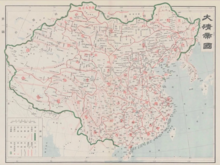

The Qing dynasty (1644–1912) was the most populated country on Earth for nearly two centuries and had a large and varied economy. The High Qing era saw a period of rapid demographic and economic growth, followed by a near century of stagnation brought about by the unequal treaties, rebellions, floods, and a fiscally conservative and decentralised government.
The period up to the High Qing era has been described by scholars as a second commercial revolution, even more transformative than the first, which occurred during the Song dynasty. By the end of the 18th century a "circulation economy" or "commodity economy" developed, in which commercialization penetrated local rural society to an unprecedented degree.[1][2] During this period the European trend to imitate Chinese artistic traditions, known as chinoiserie gained great popularity in Europe in the 18th century due to the rise in trade with China and the broader current of Orientalism.[3]
- ^ Rowe, William (2010), China's Last Empire - The Great Qing, Harvard University Press, p. 123, ISBN 9780674054554
- ^ "Merchant Culture in the Material World of Eighteenth-Century China". Retrieved March 6, 2024.
- ^ Beevers, David (2009). Chinese Whispers: Chinoiserie in Britain, 1650–1930. Brighton: Royal Pavilion & Museums. p. 19. ISBN 978-0-948723-71-1.